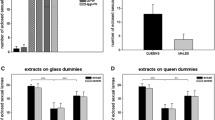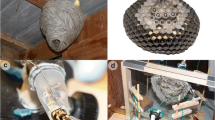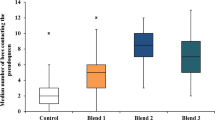Abstract
The control of caste formation in the harvester termiteHodotermes mossambicus (Hagen) was investigated.
Normal laboratory colonies contained a primary reproductive pair, between 6.59 and 24.98% workers, 0.39 and 3.45% soldiers and 74.64 and 92.06% larvae. Supplementary reproductives did not develop in colonies deprived of their king and queen. Continuous removal of soldiers stimulated soldier production. We have suggested that a pheromone produced by the soldiers plays a major role in controlling the soldier population of a colony. A similar phermone system appreared to control the production of workers.
Evidence was also obtained that the primary reproductive pair influenced the production of workers and soldiers.
Similar content being viewed by others
Literature
Butler (C. G.), 1965. — Die Wirkung von Königinnen Extrakten verschiedenen sozialer Insekten auf die Aufzucht von Königinnen und die Entwicklung der Ovarien von Arbeiterinnen der Honigbiene.Z. Bienenforsch.,8, p. 143–147.
Butler (C. G.), 1967. — Insect pheromones.Biol. Rev.,42, p. 42–87.
Coaton (W. G. H.), 1958. — The Hodotermitid harvester termites of South Africa.Sci. Bull. 375,Dep. Agric. Un. S. Afr.
Light (S. F.), 1943. — The determination of the castes of social insects.Q. Rev. Biol.,18, p. 46–63.
Light (S. F.), 1944. — Experimental studies on ectohormonal control of the development of supplementary reproductives in the termite genusZootermopsis formerlyTernopsis.Univ. Calif. Publs. Zool.,43, p. 413–454.
Lüscher (M.), 1961. — Social control of polymorphism in termites. InInsect Polymorphism, p. 57–67. Ed. J. S. Kennedy. Symposium No. 1,R. ent. soc. Lond.
Lüscher (M.), 1963. — Functions of the corpora allata in the development of termites.Proc. XVI Inter. Cong. Zool., p. 224–250.
Nel (J. J. C.), 1968a. — Die invloed van temperatuur en relatiewe humiditeit op die gewigsverlies en oorlewing van die grasdraertermiete,Hodotermes mossambicus (Hagen) en.Trinervitermes trinervoides (Sjöstedt).S. A. Tydskrif Landbouwet.,11, p. 389–402.
Zel (J. J. C.), 1968b. — Aggressive behaviour of the harvester termitesHodotermes mossambicus (Hagen) andTrinervitermes trinervoides (Sjöstedt).Ins. soc.,15, p. 145–156.
Nel (J. J. C.), 1968c. — Verspreiding van die oesgate en grondhopies van die grasdraertermiet,Hodotermes mossambicus (Hagen) (Isoptera: Hodotermitidae).S. A. Tydskrif. Landbouwet.,11, p. 173–182.
Nel (J. J. C.), Hewitt (P. H.), Smith (L. J.) andSmit (W.). —J. ent. Soc. sth. Afr.,32, p. 9–24.
Torre-Bueno (J. R.) de la, 1937. —A glossary of entomology. Publishers, Brooklyn Entomological Society, Brooklyn, N. Y.
Author information
Authors and Affiliations
Rights and permissions
About this article
Cite this article
Hewitt, P.H., Nel, J.J.C. & Conradie, S. Preliminary studies on the control of caste formation in the harvester termiteHodotermes mossambicus (Hagen). Ins. Soc 16, 159–172 (1969). https://doi.org/10.1007/BF02223407
Issue Date:
DOI: https://doi.org/10.1007/BF02223407




